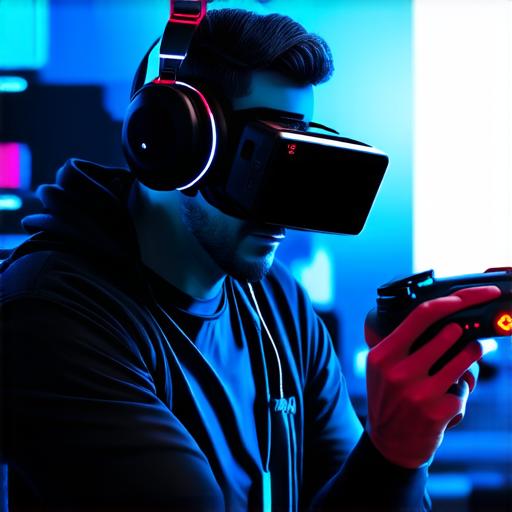
Understanding the mechanics of virtual reality games
Introduction:
Virtual reality (VR) is an exciting and rapidly growing technology that allows users to experience immersive digital environments. VR games have become increasingly popular in recent years, with many developers creating unique and innovative experiences that push the boundaries of what is possible in gaming. However, for those who are new to the world of VR gaming, understanding the mechanics of these games can be challenging.
1. The basics of VR:
To understand the mechanics of VR games, it is important to first understand the basic principles of VR technology. VR works by creating an illusion of immersion through the use of sensors and headsets that track the movements of the user in real time. This allows the user to feel as though they are physically present within the virtual environment, even though they are actually sitting in a room with a headset on.
2. VR controllers:
One of the most important tools for interacting with VR games is the controller. VR controllers typically consist of handheld devices that are equipped with sensors and buttons. These controllers allow the user to track their movements and manipulate virtual objects within the game world. Some VR games also use additional peripherals, such as gloves or motion chairs, to further enhance the immersion of the experience.
3. Motion sickness:
One of the most common issues that users face when playing VR games is motion sickness. This can be caused by a variety of factors, including the disconnect between the user’s real-world movements and the virtual environment, as well as the high level of visual and auditory stimulation that VR games can provide. To minimize the risk of motion sickness, it is important to use comfortable seating and to adjust the game settings to your own preferences.
4. Tracking:
The accuracy and reliability of tracking are crucial factors in the success of a VR game. If the sensors used to track the user’s movements are not accurate or if there is lag between the user’s real-world movements and their virtual avatar, it can make the game difficult to control and frustrating to play. To ensure smooth and reliable tracking, it is important to use high-quality sensors and to optimize the game settings for your specific hardware.
5. Graphics and performance:
The graphics and performance of a VR game are also important factors that can greatly impact the user’s experience. High-quality graphics can create a sense of realism that enhances immersion, while poor graphics can detract from the overall experience and make it difficult to enjoy the game. Performance is also critical, as lag or stuttering can cause disorientation and make the game difficult to control.
6. Game design:
Finally, the design of the game itself is a critical factor in determining its success. VR games should be designed with immersion and interactivity in mind, using intuitive controls and engaging mechanics that allow the user to fully explore the virtual environment. Additionally, the game world should be designed to encourage exploration and discovery, providing a sense of wonder and excitement that keeps the user engaged throughout the experience.

Conclusion:
Virtual reality games are a fascinating and rapidly growing technology that has the potential to provide users with truly immersive and engaging experiences. However, understanding the mechanics of these games can be challenging for those who are new to the world of VR gaming. By exploring some of the key concepts and techniques that underpin VR game design, we can gain a deeper appreciation for the complexity and creativity required to create these innovative experiences.
FAQs:
How do I choose the right VR headset for my needs? There are many different VR headsets available on the market, each with its own strengths and weaknesses. When choosing a VR headset, it is important to consider factors such as your budget, your space requirements, and the specific features that you need in order to have the best possible experience. Some popular VR headsets include the Oculus Rift, HTC Vive, and PlayStation VR.
What are some common causes of motion sickness in VR games? Motion sickness can be caused by a variety of factors, including the disconnect between the user’s real-world movements and the virtual environment, as well as the high level of visual and auditory stimulation that VR games can provide. To minimize the risk of motion sickness, it is important to use comfortable seating and to adjust the game settings to your own preferences.
How do I optimize my VR game for performance? To ensure smooth performance in a VR game, it is important to use high-quality sensors and to optimize the game settings for your specific hardware. Additionally, you should test the game thoroughly before release and make any necessary adjustments to improve performance.
What are some common challenges faced by developers when creating VR games? Developers face a variety of challenges when creating VR games, including tracking accuracy, motion sickness, and graphics performance. In addition, designing for immersion and interactivity can be challenging, as developers must create engaging mechanics that allow the user to fully explore the virtual environment.